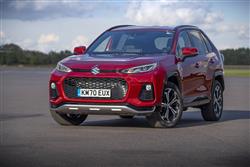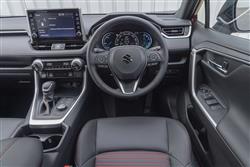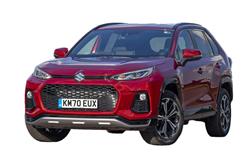Suzuki Across - ABC Leasing
CROSS PURPOSES(some text hidden)
By Jonathan Crouch
Ten Second Review word count: 74
Suzuki, always known for their dependable and reliable SUV's, are entering a more expensive sector of the market with the larger and slightly more aspirational Across model. If it looks more than a little familiar to you, then that's because it's almost entirely based on a Toyota RAV4 - the Plug-in version to be specific. This as a result of a new collaboration with Toyota. But can the Across make its own distinct mark?
Background word count: 165
Smaller Japanese makers aren't having an easy time in the European market just at present, so Suzuki's recent move to strengthen its ties with Toyota was a sensible one. And one of the results of that is this mid-sized plug-in SUV, the Across, Suzuki's take on Toyota's RAV4 PHEV. We're going to see more cloned cars of this kind in the future - one's actually already here, the Swace, Suzuki's lightly re-badged version of the Toyota Corolla Sports Tourer. What both of these models have done is to give the brand a short-cut towards the full-Hybrid engineering it desperately needs to cut its model line-up's average CO2 output in Europe and avoid punitive fines from Brussels. To date, Suzuki's own so-called 'Hybrid' engineering has actually been of the 'mild hybrid' sort that can't ever allow independent running on battery power and which, therefore, has relatively little real-world effect on economy or emissions. So being able to offer a PHEV is extremely useful for the brand.
Driving Experience word count: 296
Under the bonnet of the Across sits a 2.5-litre 4-cylinder 'Dynamic Force' engine with two electric motors, a larger more powerful one mounted at the front axle and another, slightly smaller one, at the rear. They draw their power from an 18.1 kWh battery and drive is put to the wheels through a CVT auto gearbox. The total combined power output, 306hp, is vastly more than any Suzuki has ever offered before; the 62mph sprint takes just 6 seconds. More significantly, the WLTP-rated EV driving range is 46 miles. The car has four powertrain settings. In the default 'EV' mode, the car is driven purely by the electric motors, even under hard acceleration. Selecting 'Auto EV/HV' will allow the petrol engine to contribute to the drive such as when accelerating, or at higher speed when required. Moving into 'HV' mode offers the same, whilst in 'Battery Charge' mode the engine alone will run and fully recharge the battery through energy recuperated under braking. The car's four wheel drive system, dubbed 'E-Four', utilises the independent rear electric motor to work alongside the front to split the drive depending on conditions. Power can be distributed from as much as 100% to the front axle, or split 20/80 front/rear if required. The car's 'AWD Integrated Management System' (AIM) not only controls this power flow, but also the throttle control, the gearbox, the amount of assistance given to the electronic power steering and also the brakes. This makes driving under slippery, or even just damp, conditions much more sure-footed and also enhances the handling depending on road surface. The car also offers a clever automatic limited slip differential control, 'Trail Mode', which will brake individual wheels that are losing grip, and redistribute the power to the remaining ones that aren't.
Pictures (High res disabled)

.jpg)
white.jpg)
.jpg)
white.jpg)
.jpg)
.jpg)
.jpg)
.jpg)
.jpg)
.jpg)
.jpg)
.jpg)


Scoring
Category: Compact Car
| Performance | |
| Handling | |
| Comfort | |
| Space | |
| Styling | |
| Build | |
| Value | |
| Equipment | |
| Economy | 60% |
| Depreciation | 80% |
| Insurance | 50% |
| Total | 62% |